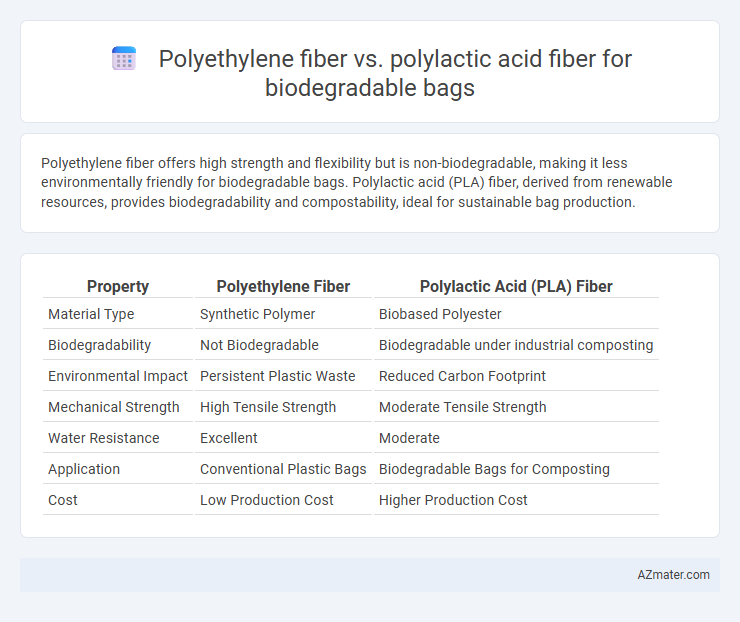Polyethylene fiber offers high strength and flexibility but is non-biodegradable, making it less environmentally friendly for biodegradable bags. Polylactic acid (PLA) fiber, derived from renewable resources, provides biodegradability and compostability, ideal for sustainable bag production.
Table of Comparison
| Property | Polyethylene Fiber | Polylactic Acid (PLA) Fiber |
|---|---|---|
| Material Type | Synthetic Polymer | Biobased Polyester |
| Biodegradability | Not Biodegradable | Biodegradable under industrial composting |
| Environmental Impact | Persistent Plastic Waste | Reduced Carbon Footprint |
| Mechanical Strength | High Tensile Strength | Moderate Tensile Strength |
| Water Resistance | Excellent | Moderate |
| Application | Conventional Plastic Bags | Biodegradable Bags for Composting |
| Cost | Low Production Cost | Higher Production Cost |
Introduction to Biodegradable Bags
Polyethylene fiber, commonly used for traditional plastic bags, offers durability and water resistance but lacks biodegradability, leading to long-term environmental pollution. Polylactic acid (PLA) fiber, derived from renewable resources like cornstarch, provides an eco-friendly alternative that decomposes naturally under industrial composting conditions. Biodegradable bags made from PLA fibers contribute significantly to reducing plastic waste and promoting sustainable packaging solutions.
Overview of Polyethylene Fiber
Polyethylene fiber, a synthetic polymer derived from ethylene monomers, is widely used for its high tensile strength, chemical resistance, and durability in various applications including packaging and bags. Unlike polylactic acid (PLA) fiber, polyethylene is not inherently biodegradable, which limits its environmental benefits but provides superior moisture resistance and mechanical properties. Its non-biodegradable nature makes recycling and waste management critical considerations when selecting polyethylene fibers for biodegradable bag alternatives.
Overview of Polylactic Acid (PLA) Fiber
Polylactic Acid (PLA) fiber is a biodegradable polymer derived from renewable resources like corn starch or sugarcane, making it an eco-friendly alternative to conventional petroleum-based polyethylene fibers used in biodegradable bags. PLA fibers offer excellent compostability under industrial conditions, breaking down into natural components within months, whereas polyethylene fibers typically require longer periods to degrade and often contribute to microplastic pollution. The mechanical properties of PLA fibers, such as tensile strength and flexibility, can be tailored through processing techniques, making them suitable for durable, yet sustainable, biodegradable bag applications.
Production Processes: Polyethylene vs PLA
Polyethylene fiber production involves polymerizing ethylene derived from fossil fuels through high-pressure processes, resulting in a non-biodegradable thermoplastic with excellent strength and durability. Polylactic acid (PLA) fiber production begins with fermenting renewable biomass like corn starch or sugarcane to produce lactic acid, which undergoes polymerization to form a biodegradable thermoplastic polyester suitable for eco-friendly bags. The key distinction lies in PLA's bio-based, compostable nature contrasting with polyethylene's petrochemical origin and resistance to natural degradation.
Environmental Impact and Biodegradability
Polyethylene fiber, derived from petrochemicals, exhibits low biodegradability and persists in the environment for centuries, contributing significantly to plastic pollution and microplastic contamination. Polylactic acid (PLA) fiber, produced from renewable resources like corn starch, offers enhanced biodegradability under industrial composting conditions, breaking down into carbon dioxide and water within months. The environmental impact of PLA fibers is comparatively lower due to reduced fossil fuel dependence and greater potential for complete biodegradation, making them more sustainable for use in biodegradable bags.
Mechanical Properties Comparison
Polyethylene fiber exhibits high tensile strength and excellent flexibility, making it durable and resistant to mechanical stress in biodegradable bags. Polylactic acid (PLA) fiber, though biodegradable and eco-friendly, typically has lower tensile strength and reduced elongation at break, resulting in less mechanical resilience under heavy loads. The mechanical properties of polyethylene fibers favor durability and reuse, while PLA fibers prioritize environmental degradation over strength performance.
Cost and Market Availability
Polyethylene fiber, commonly used in biodegradable bag manufacturing, offers lower raw material costs and widespread market availability due to its extensive production infrastructure. Polylactic acid (PLA) fiber, derived from renewable resources like corn starch, tends to be more expensive and less available globally, limiting its use primarily to niche or eco-conscious markets. Cost-efficiency and supply chain maturity make polyethylene fiber the preferred choice for large-scale biodegradable bag production, while PLA fiber appeals to premium segments targeting sustainability.
Decomposition Rates and Conditions
Polyethylene fiber decomposes very slowly, often requiring hundreds of years under natural conditions due to its high molecular weight and resistance to microbial attack. Polylactic acid (PLA) fiber, derived from renewable resources, biodegrades significantly faster, typically breaking down within 6 to 12 months in industrial composting facilities where temperatures exceed 58degC and moisture levels are controlled. The enhanced decomposition rate of PLA fibers under specific composting conditions makes them a more environmentally friendly choice for biodegradable bags compared to conventional polyethylene fibers.
Applications in Biodegradable Bags
Polyethylene fiber is widely used in biodegradable bags for its strong mechanical properties and moisture resistance, making it suitable for durable packaging and waste containment. Polylactic acid (PLA) fiber offers excellent biodegradability and compostability, ideal for eco-friendly bags intended for short-term use and organic waste disposal. PLA fiber's renewable origin from corn starch or sugarcane enhances the environmental benefits of biodegradable bags compared to fossil fuel-based polyethylene fibers.
Future Trends and Innovations
Polyethylene fiber, widely used for its durability and low cost, faces increasing environmental scrutiny, driving innovation towards biodegradable alternatives like polylactic acid (PLA) fiber made from renewable resources such as corn starch. Future trends emphasize enhancing PLA fiber's mechanical strength and biodegradation rate through advanced polymer blending and nanocomposite technologies to meet performance standards of traditional polyethylene bags. Innovations also include developing hybrid fibers combining PLA with additives to improve moisture resistance, expanding applications in high-barrier biodegradable packaging solutions.

Infographic: Polyethylene fiber vs Polylactic acid fiber for Biodegradable bag
 azmater.com
azmater.com